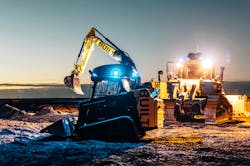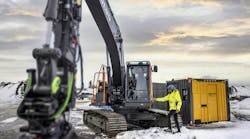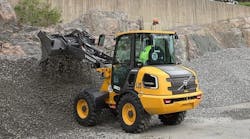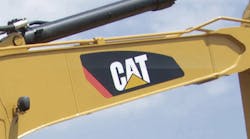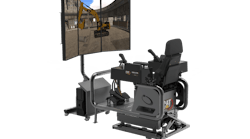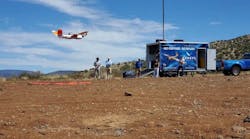Autonomous construction equipment is not merely the fanciful stuff of far-flung iron ore mines in Australia—these robotic machines are slowly gaining advocates here in North America—where we will see smaller, familiar pieces of equipment run autonomously and find homes on the job sites of the not-too-distant future.
Robotic construction, a natural progression from the GPS, telematics, and machine-control offerings already helping fleets be more productive and efficient, is continually being refined, and early adopters willing to experiment with it report that autonomous machines show promise.
As with all tech, proven performance and a positive effect on the bottom line will drive acceptance.
Mortenson Construction, a Minnesota-based family-owned construction company that provides planning, program management, general contracting, design-build, and turnkey development has experimented with autonomous equipment for wind turbine projects.
The company’s wind and solar projects are naturals for evaluating robotic machinery because of their large size and the fact they’re often found in remote areas, making them hard to keep staffed with operators. Add in the current skilled operator shortage and the fact these projects may take on more urgency under a likely more environmentally focused Biden administration in Washington, and an autonomous future is easier to imagine.
Derek Smith, lean innovation manager for the company’s civil group, told the journal Inside Unmanned Systems the nature of the company’s renewable sites lend themselves to autonomy.
“Tasks such as turbine foundation excavation are very repetitive,” Smith said. “The idea of a robotic excavator capable of digging those foundations is very appealing.”
Mortenson entered into a partnership with Built Robotics to test autonomous excavators.
Robotic construction
Built Robotics upgrades off-the-shelf heavy equipment from a number of well-known OEMs with Artificial Intelligence (AI) guidance systems to enable them to operate fully autonomously. It concentrates its efforts on crawler dozers, crawler excavators, and compact track loaders.
Built, which terms the modified equipment as “robots,” also adds a safety system integrated with the AI, and says its fleet has worked for over 10,000 hours with a perfect safety record. Sensors detect workers, other vehicles, and even animals. A geofence component ensures that equipment operation is confined to a specified work zone. Also, a wireless emergency stop feature means that observers can remotely stop operation at any time.
Guidance systems are typically mounted atop the cabs of the iron. They look a little bit like a high-tech car rooftop luggage rack.
The company has completed a dozen autonomous projects on two continents so far. It says that escalating infrastructure demands call out for robotic solutions.
Built founder and CEO Noah Ready-Campbell has noted that construction machinery and practices have not changed all that much in the past century, considering the amount of time that has passed. What was done by steam and cables is now done by precision hydraulics. He’s convince the next sea change will come strictly through software.
“We really believe that’s what going to happen next is you’re not going to see the innovation on the mechanical side, and instead you’re going to see it on the software side,” Ready-Campbell said. “You don’t necessarily need to have a person who’s in there moving every single lever.”
For Mortenson, Built worked its magic on a wind farm development project.
Typically, the contractor would use a large excavator to dig wind turbine foundations in an operation that would take about five hours. Using a smaller, autonomous excavator modified for autonomous operation by Built, 21 out of a total of 229 excavations were done in nearly 10 hours each—that’s digging the hole plus finishing the pedestrian and equipment ramps—providing a glimpse of what could be done on a larger scale with multiple autonomous units.
The productivity gains could be impressive.
“Our operators can monitor more than one robotic excavator and these machines can feasibly run 24 hours,” Smith said.
Smith told the journal that operators were skeptical of the autonomy, at first.
“Our operators work closely with [Built Robotics] engineers to develop the optimal excavation strategy, from digging the hole to managing the spoils,” Smith said. “We made them part of the process and reinforced that these machines are a supplement to their job and minimize wear and tear on their bodies from long shifts sitting in a cab. Now, they’re really excited.”
Mortenson’s Nick Schweitz, civil group product manager, told Built that he was impressed.
“Built’s technology is amazing,” he said. “Over the course of our partnership, we’ve seen them make tremendous progress in just a few months. Looking ahead, I believe they will make a significant contribution to our production and accelerate our schedules on renewables projects across the country.”
Indeed, Inside Unmanned Systems reported that one of Mortenson’s next applications of autonomous systems will be in trenching for wires and cables involved in solar power construction.
Data plays a role for Mortenson as well. It maps its site with Trimble MX2 (today’s MX9) mobile mapping technology.
The MX9 is designed to be a complete field-to-finish mobile mapping solution that combines the latest vehicle-mounted hardware with field software to produce an integrated office software workflow.
It uses GNSS and inertial technology, and dual- and single-laser configurations based on site needs.
Mortenson has also used the Quantm Alignment Planning System to automate complex calculations needed to align and optimize wind farm road routing.
Data has played a huge role in autonomous undertakings so far by some familiar industry names. Komatsu and Caterpillar already have machines in the field, particularly in mining applications overseas, and Volvo CE with partner Skanska has demonstrated an entire quarry operating with autonomous haulers with mostly battery-electric equipment.
Mining companies have now hauled more than three billion metric tons of materials leveraging Komatsu’s FrontRunner Autonomous Haulage System.
First deployed in 2008 at a copper mine in Chile, AHS brings together dump trucks with Modular Mining Systems’ DISPATCH Fleet Management System.
Today’s FrontRunner system operates around the clock, hauling copper, iron ore, oil sands, and coal at 11 customer sites across three continents. At the end of the first half of 2020, there were 251 trucks in operation, Komatsu said.
“Our mining customers’ ongoing investment in technology and equipment to transition to autonomous haulage underscores the value the system provides,” said Toshio Kurokawa, GM of marketing, mining business division, Komatsu. “We are honored that autonomous haulage has been a valuable resource to help our customers mitigate risks associated with the global Covid-19 pandemic,” Kurokawa said.
The FrontRunner system is designed to enable manually operated equipment (such as loaders, dozers, graders, and light vehicles) to seamlessly interact in an autonomous truck environment. Komatsu recently introduced system functionality to enable manual haul trucks to also operate with the autonomous trucks.
Ride along in a Komatsu 980E autonomous haul truck in the video below.
Early last year, Caterpillar celebrated 2 billion tons hauled using its MineStar Command system for autonomous hauling. The company says it has doubled the amount hauled in the 16 months since reaching 1 billion tons hauled in November 2018.
“In just a bit over six years we’ve safely hauled 2 billion tons,” said Sean McGinnis, MineStar Solutions product manager.
Over the past seven years, MineStar Solutions has also continued to grow its expertise in autonomous operations—not only in hauling but also with autonomous dozers, drills, and underground loaders.
Since commercially launching Command for hauling in 2013, Caterpillar has continued to improve the speed of implementation. “We’re launching Command on more sites and implementing it more quickly, so more of our customers can experience the safety and productivity gains that autonomous hauling delivers,” said McGinnis.
As more data becomes available and more is learned from autonomous applications, the more expertise the manufacturers will bring to bear for use on varied, everyday job sites, and mines will not be the only places to find working equipment with empty operator’s stations.
